
Suillus luteus is a bolete fungus, and the type species of the genus Suillus. A common fungus native all across Eurasia from Ireland to Korea, it has been introduced widely elsewhere, including North and South America, southern Africa, Australia and New Zealand. Commonly referred to as slippery jack or sticky bun in English-speaking countries, its names refer to the brown cap, which is characteristically slimy in wet conditions. The fungus, initially described as Boletus luteus by Carl Linnaeus in 1753, is now classified in a different fungus family as well as genus. Suillus luteus is edible, though not as highly regarded as other bolete mushrooms. It is commonly prepared and eaten in soups, stews or fried dishes. The slime coating, however, may cause indigestion if not removed before eating. It is often sold as a dried mushroom.

Neolentinus lepideus is a basidiomycete mushroom of the genus Neolentinus, until recently also widely known as Lentinus lepideus. Common names for it include scaly sawgill, scaly lentinus and train wrecker.

Inocybe geophylla, commonly known as the earthy inocybe, common white inocybe or white fibercap, is a poisonous mushroom of the genus Inocybe. It is widespread and common in Europe and North America, appearing under both conifer and deciduous trees in summer and autumn. The fruiting body is a small all-white or cream mushroom with a fibrous silky umbonate cap and adnexed gills. An all-lilac variety lilacina is also common.

Tricholoma terreum, commonly known as the grey knight or dirty tricholoma, is a grey-capped mushroom of the large genus Tricholoma. It is found in coniferous woodlands in Europe, and has also been encountered under introduced pine trees in Australia and New Zealand. It is regarded as edible. A 2014 article speculated that it may be poisonous, but Sitta et al. in 2016 published in the same journal a counter article demonstrating the unfounded nature of such speculation.

Pholiota flammans, commonly known as the yellow pholiota, the flaming Pholiota, or the flame scalecap, is a basidiomycete agaric mushroom of the genus Pholiota. Its fruit body is golden-yellow in color throughout, while its cap and stem are covered in sharp scales. As it is a saprobic fungus, the fruit bodies typically appear in clusters on the stumps of dead coniferous trees. P. flammans is distributed throughout Europe, North America, and Asia in boreal and temperate regions. Its edibility has not been clarified.

Tricholoma saponaceum, also known as the soap-scented toadstool, soapy tricholoma, soapy knight or soap tricholoma is an inedible mushroom found in woodlands in Europe and North America.
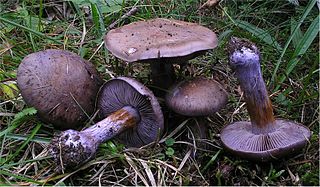
Thaxterogaster purpurascens is a species of mushroom producing fungus in the family Cortinariaceae. It is commonly known as the bruising webcap.

Cortinarius anomalus, also known as the variable webcap, is a basidiomycete fungus of the genus Cortinarius. It produces a medium-sized mushroom with a grayish-brown cap up to 5 cm (2 in) wide, gray-violet gills and a whitish stem with pale yellow belts below. The mushroom grows solitarily or in scattered groups on the ground in deciduous and coniferous forests. It is found throughout the temperate zone of the northern hemisphere.
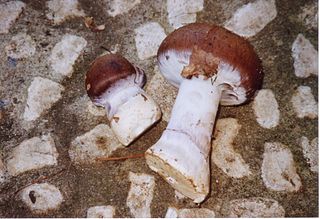
Cortinarius praestans, also known as the goliath webcap, is a basidiomycete mushroom of the genus Cortinarius. The mushroom has orangish-yellow caps that reach up to 20 cm (7.9 in) in diameter, and thick club-shaped stipes up to 15 cm (5.9 in) long. The edible mushroom is found in Europe.

Hygrophorus purpurascens, commonly known as the purple-red waxy cap, is a species of agaric fungus in the family Hygrophoraceae. Its cap has a pink background color with streaks of purplish red overlaid, and mature gills have red spots.

Amanita albocreata, also called the ringless panther or the ringless panther amanita, is a species of fungus in the family Amanitaceae. It was discovered in 1944, by William Murrill. It is commonly found in the northeastern United States and parts of southeastern Canada. It normally grows between the rainy months of June and August.

Tricholoma atrosquamosum, commonly known as dark-scaled knight, is an edible gilled mushroom native to Europe. The grey-capped fruit bodies are generally found singly or in small groups in deciduous woodland on chalk-based soils.
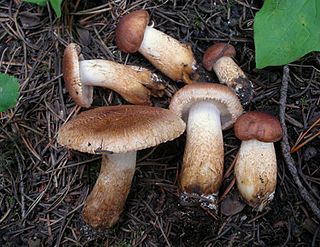
Tricholoma vaccinum, commonly known as the russet scaly tricholoma, the scaly knight, or the fuzztop, is a fungus of the agaric genus Tricholoma. It produces medium-sized fruit bodies (mushrooms) that have a distinctive hairy reddish-brown cap with a shaggy margin when young. The cap, which can reach a diameter of up to 6.5 cm (2.6 in) wide, breaks up into flattened scales in maturity. It has cream-buff to pinkish gills with brown spots. Its fibrous, hollow stipe is white above and reddish brown below, and measures 4 to 7.5 cm long. Although young fruit bodies have a partial veil, it does not leave a ring on the stipe.
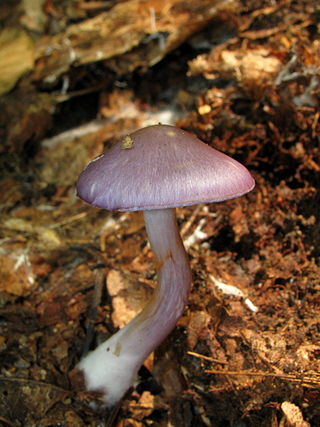
Cortinarius iodes, commonly known as the spotted cort or the viscid violet cort, is a species of agaric fungus in the family Cortinariaceae. The fruit bodies have small, slimy, purple caps up to 6 cm (2.4 in) in diameter that develop yellowish spots and streaks in maturity. The gill color changes from violet to rusty or grayish brown as the mushroom matures. The species range includes eastern North America, Central America, northern South America, and northern Asia, where it grows on the ground in a mycorrhizal association with deciduous trees. The mushroom is not recommended for consumption. Cortinarius iodeoides, one of several potential lookalike species, can be distinguished from C. iodes by its bitter-tasting cap cuticle.

Tricholoma vernaticum is an agaric fungus of the genus Tricholoma native to the Pacific Northwest region of the United States. The fungus was originally described in 1976 as a species of Armillaria when that genus was more inclusive; it received its current name twenty years later. The stout fruit bodies (mushrooms) have moist white to grayish caps, a membranous ring on the stipe, and an odor resembling cucumbers. Mycorrhizal with conifers, the fungus fruits in the spring or early summer, with its mushrooms appearing on the ground singly or in groups at high elevations, often at the edge of melting snowbanks. The edibility of the mushroom is unknown, but it has a strong unpleasant odor and a mealy taste.
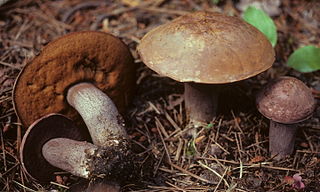
Sutorius eximius, commonly known as the lilac-brown bolete, is a species of fungus in the family Boletaceae. This bolete produces fruit bodies that are dark purple to chocolate brown in color with a smooth cap, a finely scaly stipe, and a reddish-brown spore print. The tiny pores on the cap underside are chocolate to violet brown. It is widely distributed, having been recorded on North America, South America, and Asia, where it grows in a mycorrhizal relationship with both coniferous and deciduous trees.

Imleria badia, commonly known as the bay bolete, is an edible, pored mushroom found in Eurasia and North America, where it grows in coniferous or mixed woods on the ground or on decaying tree stumps, sometimes in prolific numbers. Both the common and scientific names refer to the bay- or chestnut-coloured cap, which is almost spherical in young specimens before broadening and flattening out to a diameter up to 15 cm (6 in). On the cap underside are small yellowish pores that turn dull blue-grey when bruised. The smooth, cylindrical stipe, measuring 4–9 cm long by 1–2 cm thick, is coloured like the cap, but paler. Some varieties have been described from eastern North America, differing from the main type in both macroscopic and microscopic morphology.
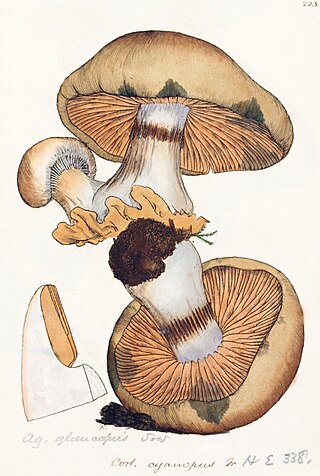
Phlegmacium glaucopus is a species of fungus in the family Cortinariaceae. It is commonly known as the blue-foot webcap.

Hygrophorus russula, commonly known as the pinkmottle woodwax, false russula, or russula-like waxy cap, is a fungus native to North America and Europe.
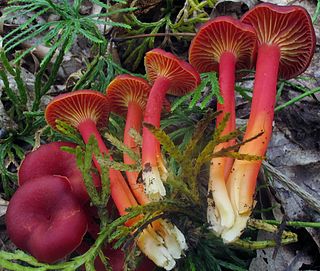
Hygrocybe appalachianensis, commonly known as the Appalachian waxy cap, is a gilled fungus of the waxcap family. It is found in the eastern United States, where it fruits singly, in groups, or clusters on the ground in deciduous and mixed forests. The species, described in 1963 from collections made in the Appalachian Mountains, was originally classified in the related genus Hygrophorus. It was transferred to Hygrocybe in 1998, in which it has been proposed as the type species of section Pseudofirmae.




















